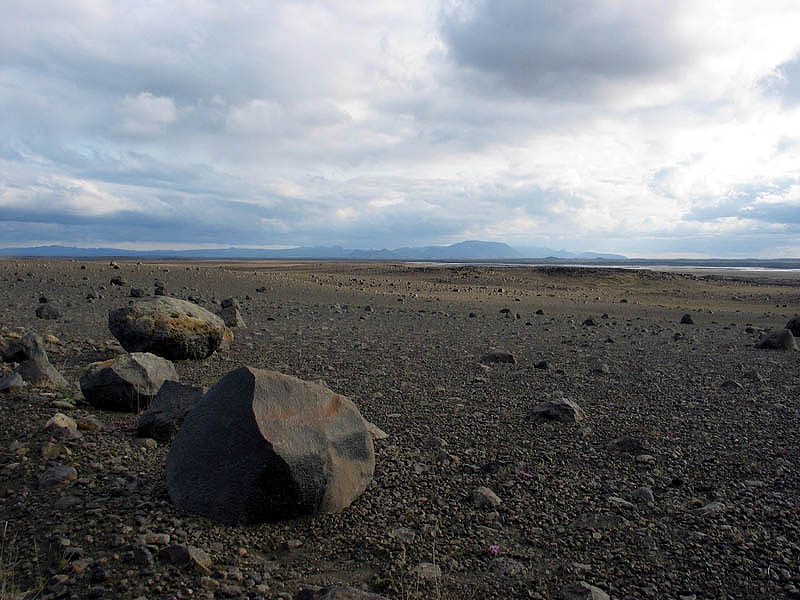 HOLASANDUR
Holasandur
(The Sand of Hills) is a desert between Husavik and Lake
Myvatn. It is 130 square km
area of black sand. Here the destroying forces of nature and
humans have been
playing around for almost 300 years. The result of that interplay is
this
desert surrounded by a relatively
good soil and well grown land. This desert is man-made at
only
270 to 400 meters above sea level. HOLASANDUR
Holasandur
(The Sand of Hills) is a desert between Husavik and Lake
Myvatn. It is 130 square km
area of black sand. Here the destroying forces of nature and
humans have been
playing around for almost 300 years. The result of that interplay is
this
desert surrounded by a relatively
good soil and well grown land. This desert is man-made at
only
270 to 400 meters above sea level.
Here you can see one of the biggest land care
project in Europe. If the project works, it can be used to get
rid
of man-made deserts in Iceland. Iceland has lost over 80% of its
valuable soil after the settlement.
This vegetative
improvement project is a new approach to restore the quality
of land in our country. The area was a well grown highland
with
birch bushes and wild salix. Remains of coal production has been
discovered in the sand, which tells us that even trees were growing in
the area. To be able to stop the
degradation, it is necessary to cover the area with some kind of
vegetation. Alaska lupine is used for that purpose. The lupine
produces fertilizer and is a supplier of fertilizer to other plants.
The lupine prepares the soil for higher level of flora. Birch,
salix and other types of higher plants are being planted in islands on
the sand. These green islands will supply the land with seeds in the
future.
In a
project of this magnitude and with
the limited financial resources available, it is not possible to use
grass and fertilizers, which is the classical method in land
conservation. It will cost ten (10) times more. IT will cost
"one thousand million"
Icelandic kronur, instead of "one hundred million" Icelandic
krónur, to
use grass and fertilizers, rather than to use the inherent
fertilizing effect of the lupine. The lupine will become self
sustainable in the desert and prepare the soil for other plants.
The
History of the project
In
the year 1992 a few people interested in land care came together and
decided to regain the prosperous earth that is lost. In association
with the State Soil Conservation Service, "Landgraedsla
ríkisins", a ten
years plan was designed with the purpose to recover the soil on
Holasandur. The total cost was estimated around 100-120 million
Icelandic krónur. It was reasoned that the only practical
method was to
plant seed of lupines in the sand by special machines.

The
land care group ("HUSGULL") collected money for these special machines
that are
used for planting the lupine in the sand. Already at that time, many
individuals, shop owners and big companies wanted to join forces with
our little green army.
The
plastic bag you buy in the store for your goods is the financial
background for the project. The association of shop owners in Iceland
decided that the income from selling these bags should go to
environmental projects. The Holasandur project has been rewarded 4-5
million Icelandic krónur per year during the last
ten years from this
clever plastic bag fund.
What you
will see at Holasandur, is the first step to overcome a desert.
The critical step is to recover the soil, and the lupine takes care
of that. Secondly we are planting trees in certain
spots in
the lupine fields and these islands of trees, are supposed to act as a
seed reservoir in the future. It has been estimated that it will take
at least 200 years to repair the damages here.
It is worth
to notice that this project was subjected to heavy environmental
regulations. It is called: “Evaluation of the possible
harmful
effect by the activity on the environment”. The
project was
thus placed in category with nuclear plants and major building plans
and this was forced by fanatics in the environmental society, who
claimed that the black sand was worth protecting and that soil,
plants
and trees were a challenge to the black sand,.
Black
sand is truly
not endangered species here in Iceland.
Some
people might say: "But
the desert is so nice to watch!!!"
Most
people would answer: "Maybe
through the windows of the bus, but there is no shortage of
deserts in the Icelandic highlands. Deserts are terrible to
live
with".
We
know
that you think it is bizarre, to see all these sheeps running around
freely and feeding themselves on the last
remains of Birch. At the same time the nation is spending a
lot
of energy and a lot of money planting trees in fences and to build
fences around a relatively small part of the Birch remains in some
places, to fight land erosion, which is mainly the
result of overgrazing. We can neither control the weather, nor the
volcanoes but we could control the grazing.
We must
realize that we are all part of nature, not just the scientists. It is
best for our environment that people learn to appreciate nature by
actively enjoying it. To show care and responsibility is what matters,
not regulations and restrictions. Overprotection and the
misunderstanding that nature is untouchable, is hindering people in
living with nature and stopping people from taking action . The project
is open to everyone to take part. If we do not
care , who does?
 
|